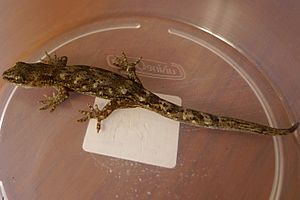New Zealand common gecko facts for kids
Quick facts for kids New Zealand common gecko |
|
|---|---|
 |
|
| A common gecko, photographed in a garden in Wellington, 2013. | |
| Scientific classification | |
| Genus: |
Woodworthia
|
| Species: |
maculata
|
| Synonyms | |
|
Naultinus maculatus Gray, 1845 |
|
The Woodworthia maculata, also known as the New Zealand common gecko or Raukawa gecko, is a type of gecko found in New Zealand. Its scientific name, maculata, means "speckled". This name refers to the patterns you can see on its skin.
Contents
Conservation Status
The New Zealand Department of Conservation (DOC) checks on how well different animals are doing. In 2012, they said the common gecko was "Not Threatened". This means there are enough of them, and they are not in danger of disappearing.
How to Identify a Common Gecko
The W. maculata is a small to medium-sized gecko. It usually grows to about 15.5 centimeters long. Most common geckos are grey or brown. As its name suggests, it has a speckled pattern on its body.
Its eyes are a greenish-brown color. The distance from its snout to its eye is about the same as the distance from its eye to its ear. The inside of its mouth is pink, and its tongue is also pink with a grey tip.
Sometimes, the common gecko lives in the same places as two other similar-looking geckos: Dactylocnemis pacificus and W. chrysosireticus.
You can tell W. maculata apart from W. chrysosireticus because W. maculata does not have black speckles. To tell it apart from D. pacificus, look closely at its nostril. In W. maculata, the scale around the nostril does not touch the nostril itself. But in D. pacificus, it does.
Where Common Geckos Live (Range)
W. maculata can be found all over New Zealand. However, geckos from different parts of the country can look a bit different. This is especially true for those in the North Island.
Geckos in the South Island are often thinner and darker. Those in the North Island can be larger and come in many colors. You usually won't find this gecko on Stewart Island.
In the Hauraki Gulf, these geckos are often found on stony beaches. They are smaller and have wavy stripes along their bodies. Geckos found in the Coromandel and central North Island are usually larger. They live in lowland forests and come in various colors.
In the southern North Island, populations of geckos can be two-thirds smaller than nearby groups. Males and females in these areas also look different from each other (this is called sexual dimorphism). Geckos living around the Cook Strait are a mix of the common North and South Island types.
Where Common Geckos Like to Live (Habitat Preferences)
The W. maculata is a land animal, meaning it lives on the ground. But it is often found in trees, especially in forest areas. A study showed that these geckos also like rocky places. They prefer areas with cracks and crevices, even if there is no permanent shade. Not many geckos were found in places where animals had eaten all the grass.
Life Cycle and How Long They Live
Common geckos are known to live for a very long time. It is thought they can live for about 20 years. Some have even been found to be 29 years old. A more recent study suggests they might live up to 37 years in the wild! Scientists think they live so long to make up for how slowly they have babies.
Female common geckos usually have less than two babies each year. They also take a long time to grow up and become adults.
What Common Geckos Eat and Who Eats Them
Geckos have a simple diet. They eat live insects and other small creatures. Their meals can include spiders, isopods (small crustaceans), moths, flies, grasshoppers, and caterpillars. What a gecko eats can change depending on its size and where it lives.
Some gecko species can store fat in their tails. This fat acts like a food reserve for times when food is hard to find. Most geckos find it hard to digest tough plant material like leaves. However, W. maculata and other New Zealand geckos can eat plant parts that are easy to digest and full of energy. These include pollen, nectar, sap, or fruit.
On the main islands of New Zealand, common geckos are often hunted by animals that were brought to the country. These include stoats, cats, hedgehogs, and rodents. On offshore islands, where these new animals are not present, the morepork (a native owl) is the main predator. Rodents are especially dangerous because they eat both adult geckos and their eggs. Even though W. maculata are too small to fight off rodents, their heads are too big to fit into the tiny cracks where they might be safe.

